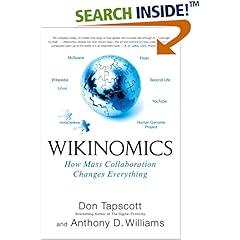
Chris Anderson is writing a new book called FREE (you can click the link to learn more and vote on the subtitles; my favorite is “How $0.00 changed the world.”) In a subsequent post he includes a link to the site where large excerpts of his best-seller, The Long Tail, are available for free. His publisher will be offering his new book as a free downloadable audiobook, and is exploring some ad-supported free book options for people who prefer print.
Here are some other examples of the free phenomenon, and one in particular that is an interesting analysis of how word-of-mouth works.
I stumbled upon Greg Stielstra’s Pyromarketing blog the other day, and signed up for the RSS feed because it Greg’s content seemed interesting and fresh. Check out this take on Vicarious Curiosity as the key to word-of-mouth:
Last Friday night my fifteen-year-old son went to see Pirates of the Caribbean III . The next morning he teased his younger sister Shelby. “You won’t believe what happens to Will,” he said. Upon hearing those words Shelby absolutely had to know what happened to Will and pestered Dominic until he divulged his secret.
Moments later Shelby came into the living room where Amy and I were enjoying our morning coffee. “Can I tell you what happened to Will in Pirates of the Caribbean,” she asked? She squirmed back and forth on the couch awaiting our answer. “Please, please, please,” she said.
What curious behavior. Why would Shelby care about the fate of a character in a movie she hadn’t yet seen. Stranger still, why would Shelby be so eager to tell me and Amy? We hadn’t even expressed any interest in knowing, yet she was desperate to tell. The answer, I think, sheds some light on the forces that power word-of-mouth.
Hopefully I’ve created the curiosity that makes you want to read the rest of his analysis here. And, of course, it made me curious to read some of his other posts.
Like this one about Scott Ginsberg, and his book “Make a Name for Yourself,” which he is giving away for free as a PDF download from blog. Scott’s story: one day after leaving a meeting, he left his “Hello, My Name Is…” nametag on, and it changed his life. You can subscribe to Scott’s RSS feed here. Or download the book for free here. I did. I hope to read it in the next few days and post a review.


Meanwhile, back at Greg’s blog, I clicked around some more and found that his book, Pyromarketing, was available as a free download audio book. I’m looking forward to listening to it as I do some yardwork.

Oh, and here’s another value…not quite free…but a great deal. Audible.com has a special right now, that gives you the first three months of its Gold level (1 credit/book per month) for half price: $7.49. I used it last night to get Wikinomics for about $10 less than I can get the hardcover version on Amazon.

But let’s get back to FREE. Here’s a site that’s a directory of the web’s best free stuff.

So, I guess Greg was right about Vicarious Curiosity. It worked to get me to write this post. I just had to tell you!
 Technorati: Free, Book, Marketing ,Chris Anderson, Pyromarketing, Greg Stielstra, Scott Ginsberg, Wikinomics, Audible.com
Technorati: Free, Book, Marketing ,Chris Anderson, Pyromarketing, Greg Stielstra, Scott Ginsberg, Wikinomics, Audible.com
 …to read this book by
…to read this book by 












